Lucas Rosenblatt
Fragments to Facts: Partial-Information Fragment Inference from LLMs
May 20, 2025Abstract:Large language models (LLMs) can leak sensitive training data through memorization and membership inference attacks. Prior work has primarily focused on strong adversarial assumptions, including attacker access to entire samples or long, ordered prefixes, leaving open the question of how vulnerable LLMs are when adversaries have only partial, unordered sample information. For example, if an attacker knows a patient has "hypertension," under what conditions can they query a model fine-tuned on patient data to learn the patient also has "osteoarthritis?" In this paper, we introduce a more general threat model under this weaker assumption and show that fine-tuned LLMs are susceptible to these fragment-specific extraction attacks. To systematically investigate these attacks, we propose two data-blind methods: (1) a likelihood ratio attack inspired by methods from membership inference, and (2) a novel approach, PRISM, which regularizes the ratio by leveraging an external prior. Using examples from both medical and legal settings, we show that both methods are competitive with a data-aware baseline classifier that assumes access to labeled in-distribution data, underscoring their robustness.
Do You Really Need Public Data? Surrogate Public Data for Differential Privacy on Tabular Data
Apr 19, 2025Abstract:Differentially private (DP) machine learning often relies on the availability of public data for tasks like privacy-utility trade-off estimation, hyperparameter tuning, and pretraining. While public data assumptions may be reasonable in text and image domains, they are less likely to hold for tabular data due to tabular data heterogeneity across domains. We propose leveraging powerful priors to address this limitation; specifically, we synthesize realistic tabular data directly from schema-level specifications - such as variable names, types, and permissible ranges - without ever accessing sensitive records. To that end, this work introduces the notion of "surrogate" public data - datasets generated independently of sensitive data, which consume no privacy loss budget and are constructed solely from publicly available schema or metadata. Surrogate public data are intended to encode plausible statistical assumptions (informed by publicly available information) into a dataset with many downstream uses in private mechanisms. We automate the process of generating surrogate public data with large language models (LLMs); in particular, we propose two methods: direct record generation as CSV files, and automated structural causal model (SCM) construction for sampling records. Through extensive experiments, we demonstrate that surrogate public tabular data can effectively replace traditional public data when pretraining differentially private tabular classifiers. To a lesser extent, surrogate public data are also useful for hyperparameter tuning of DP synthetic data generators, and for estimating the privacy-utility tradeoff.
Differential Privacy Under Class Imbalance: Methods and Empirical Insights
Nov 08, 2024
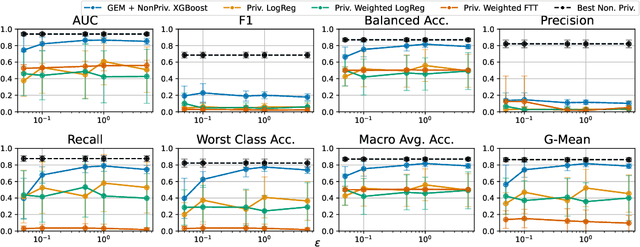
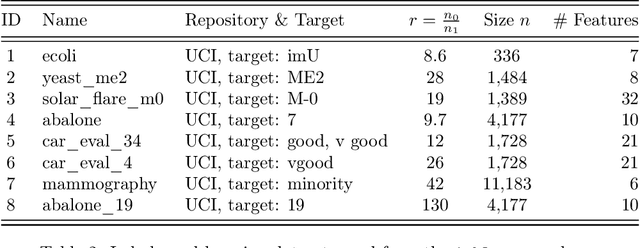

Abstract:Imbalanced learning occurs in classification settings where the distribution of class-labels is highly skewed in the training data, such as when predicting rare diseases or in fraud detection. This class imbalance presents a significant algorithmic challenge, which can be further exacerbated when privacy-preserving techniques such as differential privacy are applied to protect sensitive training data. Our work formalizes these challenges and provides a number of algorithmic solutions. We consider DP variants of pre-processing methods that privately augment the original dataset to reduce the class imbalance; these include oversampling, SMOTE, and private synthetic data generation. We also consider DP variants of in-processing techniques, which adjust the learning algorithm to account for the imbalance; these include model bagging, class-weighted empirical risk minimization and class-weighted deep learning. For each method, we either adapt an existing imbalanced learning technique to the private setting or demonstrate its incompatibility with differential privacy. Finally, we empirically evaluate these privacy-preserving imbalanced learning methods under various data and distributional settings. We find that private synthetic data methods perform well as a data pre-processing step, while class-weighted ERMs are an alternative in higher-dimensional settings where private synthetic data suffers from the curse of dimensionality.
FairlyUncertain: A Comprehensive Benchmark of Uncertainty in Algorithmic Fairness
Oct 02, 2024



Abstract:Fair predictive algorithms hinge on both equality and trust, yet inherent uncertainty in real-world data challenges our ability to make consistent, fair, and calibrated decisions. While fairly managing predictive error has been extensively explored, some recent work has begun to address the challenge of fairly accounting for irreducible prediction uncertainty. However, a clear taxonomy and well-specified objectives for integrating uncertainty into fairness remains undefined. We address this gap by introducing FairlyUncertain, an axiomatic benchmark for evaluating uncertainty estimates in fairness. Our benchmark posits that fair predictive uncertainty estimates should be consistent across learning pipelines and calibrated to observed randomness. Through extensive experiments on ten popular fairness datasets, our evaluation reveals: (1) A theoretically justified and simple method for estimating uncertainty in binary settings is more consistent and calibrated than prior work; (2) Abstaining from binary predictions, even with improved uncertainty estimates, reduces error but does not alleviate outcome imbalances between demographic groups; (3) Incorporating consistent and calibrated uncertainty estimates in regression tasks improves fairness without any explicit fairness interventions. Additionally, our benchmark package is designed to be extensible and open-source, to grow with the field. By providing a standardized framework for assessing the interplay between uncertainty and fairness, FairlyUncertain paves the way for more equitable and trustworthy machine learning practices.
Sharper Bounds for Chebyshev Moment Matching with Applications to Differential Privacy and Beyond
Aug 22, 2024Abstract:We study the problem of approximately recovering a probability distribution given noisy measurements of its Chebyshev polynomial moments. We sharpen prior work, proving that accurate recovery in the Wasserstein distance is possible with more noise than previously known. As a main application, our result yields a simple "linear query" algorithm for constructing a differentially private synthetic data distribution with Wasserstein-1 error $\tilde{O}(1/n)$ based on a dataset of $n$ points in $[-1,1]$. This bound is optimal up to log factors and matches a recent breakthrough of Boedihardjo, Strohmer, and Vershynin [Probab. Theory. Rel., 2024], which uses a more complex "superregular random walk" method to beat an $O(1/\sqrt{n})$ accuracy barrier inherent to earlier approaches. We illustrate a second application of our new moment-based recovery bound in numerical linear algebra: by improving an approach of Braverman, Krishnan, and Musco [STOC 2022], our result yields a faster algorithm for estimating the spectral density of a symmetric matrix up to small error in the Wasserstein distance.
Laboratory-Scale AI: Open-Weight Models are Competitive with ChatGPT Even in Low-Resource Settings
May 27, 2024



Abstract:The rapid proliferation of generative AI has raised questions about the competitiveness of lower-parameter, locally tunable, open-weight models relative to high-parameter, API-guarded, closed-weight models in terms of performance, domain adaptation, cost, and generalization. Centering under-resourced yet risk-intolerant settings in government, research, and healthcare, we see for-profit closed-weight models as incompatible with requirements for transparency, privacy, adaptability, and standards of evidence. Yet the performance penalty in using open-weight models, especially in low-data and low-resource settings, is unclear. We assess the feasibility of using smaller, open-weight models to replace GPT-4-Turbo in zero-shot, few-shot, and fine-tuned regimes, assuming access to only a single, low-cost GPU. We assess value-sensitive issues around bias, privacy, and abstention on three additional tasks relevant to those topics. We find that with relatively low effort, very low absolute monetary cost, and relatively little data for fine-tuning, small open-weight models can achieve competitive performance in domain-adapted tasks without sacrificing generality. We then run experiments considering practical issues in bias, privacy, and hallucination risk, finding that open models offer several benefits over closed models. We intend this work as a case study in understanding the opportunity cost of reproducibility and transparency over for-profit state-of-the-art zero shot performance, finding this cost to be marginal under realistic settings.
A Simple and Practical Method for Reducing the Disparate Impact of Differential Privacy
Dec 18, 2023



Abstract:Differentially private (DP) mechanisms have been deployed in a variety of high-impact social settings (perhaps most notably by the U.S. Census). Since all DP mechanisms involve adding noise to results of statistical queries, they are expected to impact our ability to accurately analyze and learn from data, in effect trading off privacy with utility. Alarmingly, the impact of DP on utility can vary significantly among different sub-populations. A simple way to reduce this disparity is with stratification. First compute an independent private estimate for each group in the data set (which may be the intersection of several protected classes), then, to compute estimates of global statistics, appropriately recombine these group estimates. Our main observation is that naive stratification often yields high-accuracy estimates of population-level statistics, without the need for additional privacy budget. We support this observation theoretically and empirically. Our theoretical results center on the private mean estimation problem, while our empirical results center on extensive experiments on private data synthesis to demonstrate the effectiveness of stratification on a variety of private mechanisms. Overall, we argue that this straightforward approach provides a strong baseline against which future work on reducing utility disparities of DP mechanisms should be compared.
I Open at the Close: A Deep Reinforcement Learning Evaluation of Open Streets Initiatives
Dec 12, 2023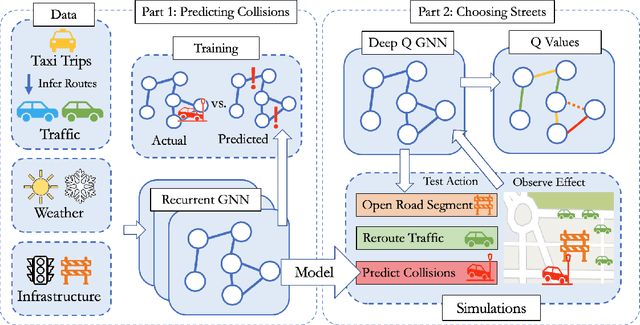

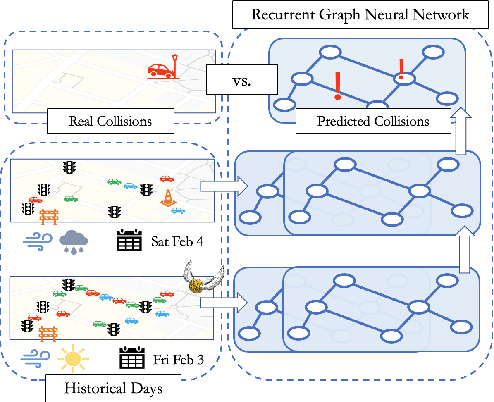
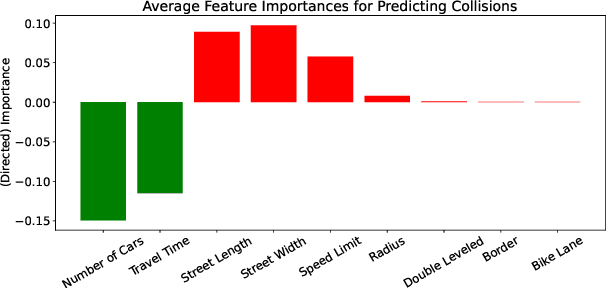
Abstract:The open streets initiative "opens" streets to pedestrians and bicyclists by closing them to cars and trucks. The initiative, adopted by many cities across North America, increases community space in urban environments. But could open streets also make cities safer and less congested? We study this question by framing the choice of which streets to open as a reinforcement learning problem. In order to simulate the impact of opening streets, we first compare models for predicting vehicle collisions given network and temporal data. We find that a recurrent graph neural network, leveraging the graph structure and the short-term temporal dependence of the data, gives the best predictive performance. Then, with the ability to simulate collisions and traffic, we frame a reinforcement learning problem to find which streets to open. We compare the streets in the NYC Open Streets program to those proposed by a Q-learning algorithm. We find that the streets proposed by the Q-learning algorithm have reliably better outcomes, while streets in the program have similar outcomes to randomly selected streets. We present our work as a step toward principally choosing which streets to open for safer and less congested cities. All our code and data are available on Github.
Top-down Green-ups: Satellite Sensing and Deep Models to Predict Buffelgrass Phenology
Oct 01, 2023



Abstract:An invasive species of grass known as "buffelgrass" contributes to severe wildfires and biodiversity loss in the Southwest United States. We tackle the problem of predicting buffelgrass "green-ups" (i.e. readiness for herbicidal treatment). To make our predictions, we explore temporal, visual and multi-modal models that combine satellite sensing and deep learning. We find that all of our neural-based approaches improve over conventional buffelgrass green-up models, and discuss how neural model deployment promises significant resource savings.
The Possibility of Fairness: Revisiting the Impossibility Theorem in Practice
Feb 13, 2023Abstract:The ``impossibility theorem'' -- which is considered foundational in algorithmic fairness literature -- asserts that there must be trade-offs between common notions of fairness and performance when fitting statistical models, except in two special cases: when the prevalence of the outcome being predicted is equal across groups, or when a perfectly accurate predictor is used. However, theory does not always translate to practice. In this work, we challenge the implications of the impossibility theorem in practical settings. First, we show analytically that, by slightly relaxing the impossibility theorem (to accommodate a \textit{practitioner's} perspective of fairness), it becomes possible to identify a large set of models that satisfy seemingly incompatible fairness constraints. Second, we demonstrate the existence of these models through extensive experiments on five real-world datasets. We conclude by offering tools and guidance for practitioners to understand when -- and to what degree -- fairness along multiple criteria can be achieved. For example, if one allows only a small margin-of-error between metrics, there exists a large set of models simultaneously satisfying \emph{False Negative Rate Parity}, \emph{False Positive Rate Parity}, and \emph{Positive Predictive Value Parity}, even when there is a moderate prevalence difference between groups. This work has an important implication for the community: achieving fairness along multiple metrics for multiple groups (and their intersections) is much more possible than was previously believed.
 Add to Chrome
Add to Chrome Add to Firefox
Add to Firefox Add to Edge
Add to Edge